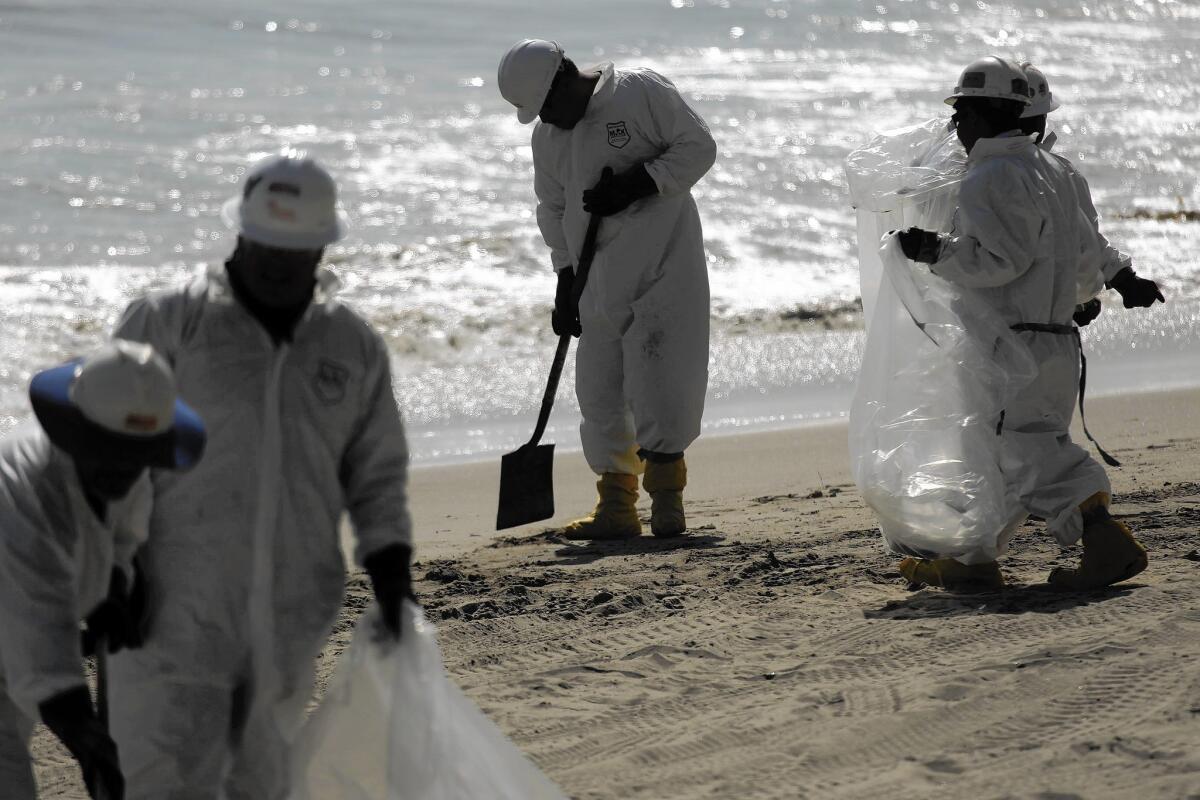Owner to check ruptured pipeline’s integrity at four other spots

The owner of the pipeline that ruptured and spilled more than 100,000 gallons of crude oil along the Santa Barbara County coast said Monday that it is going to investigate the integrity of the pipe at four additional locations after receiving preliminary inspection results.
Plains All American Pipeline will dig down to the pipeline in those areas to confirm the rough results this month from an inspection tool known as a smart pig, said Patrick Hodgins, senior director of safety and security with the company. The tool is a diagnostic device that snakes through the pipe and sends back information about its integrity.
Plains officials would not say what the preliminary inspection revealed about the condition of the pipe at these four locations.
“Maybe we need to look at the pipe thickness, maybe we need to look at if there is a potential dent or something along those lines,” Hodgins said.
He said the investigation of the four areas of Line 901, which transports crude oil from Las Floras to Gaviota and refineries throughout Southern California, is separate from the investigation of the section of pipe that ruptured last week.
A Plains spokeswoman would not disclose the four locations that would be inspected other than to say they were “not near” the ruptured section of pipeline.
As many as 101,000 gallons of crude oil spilled from the ruptured pipe, and of that about 21,000 made its way into a culvert, under U.S. 101 and into the Pacific on May 19.
State and federal agencies — including the U.S. Environmental Protection Agency, the Coast Guard and the California Department of Fish and Wildlife — have responded to the spill, along with cleanup contractors hired by Plains.
The next step in the investigation is excavating the ruptured section of pipe.
The federal Pipeline and Hazardous Materials Safety Administration and other responding agencies must all sign off on a work plan to safely remove the pipe before it is dug up and sent for metallurgical testing, said Rick McMichael, director of pipeline operations for Plains.
The oil cleared out of the pipeline totaled 18,900 to 21,000 gallons — enough to lower the worst-case estimate for how much oil had spilled to 101,000 gallons from 105,000, McMichael said.
The cleanup effort continued to ramp up over Memorial Day weekend, with 819 workers on site Monday, officials said.
As of Monday afternoon, workers had removed a total of 3,680 cubic yards of contaminated soil, sand and vegetation from the spill area and the nearly eight miles of affected beach. More than 10,000 gallons of oily water has been recovered by 16 boats working on the spill.
Miles of ocean off the biologically rich Gaviota coast was stained dark in the first days after the spill, but during a helicopter flyover of the spill area Monday, only a few scattered strains of brown coagulated oil remained.
Looking out the window of a helicopter used to coordinate the cleanup effort and spot wildlife, Sean Hastings, a National Oceanic and Atmospheric Administration resource protection coordinator, said the progress made in the last week was like “night and day.”
As the helicopter flew over the water, boats below dragged thousands of feet of boom and collected the remaining dark stains of oil in the water for skimmers to slurp up.
Other boats dragged barrier booms to prevent oil from reaching sensitive kelp beds while lengths of absorbent material called fuzzy fences dotted the coast, soaking up oil.
“I’m liking what I am seeing here,” Hastings said.
The vegetation and dirt along the oil’s path from the culvert downhill to the ocean has been ripped out, revealing what looked like a black river of stained dirt. The crevasse in the cliffs where the oil poured straight down to the beach was completely blackened.
Hastings said government officials still had to determine how oil-covered rocks along the beach would be cleaned to prevent further damage.
Seventeen oiled birds have been rescued alive while nine that have died. Five oiled sea lions and four elephant seals have been recovered, though one sea lion has died.
Twitter: @jpanzar
More to Read
Start your day right
Sign up for Essential California for news, features and recommendations from the L.A. Times and beyond in your inbox six days a week.
You may occasionally receive promotional content from the Los Angeles Times.







